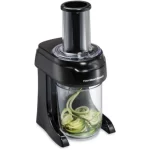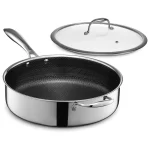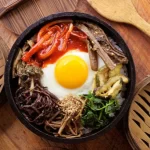Description
Bibimbap, an enticing harmony of vibrant colors and flavors, captivates both the palate and the senses. This celebrated Korean dish offers a myriad of benefits beyond its culinary delight. The symphony of fresh vegetables, savory meat, and a perfectly cooked egg not only pleases the taste buds but also provides a balanced nutritional profile packed with vitamins, minerals, and antioxidants.
Ingredients
For the Rice:
- 2 cups short-grain rice
- 2 1/4 cups water
For the Vegetables and Protein:
- 1 cup julienned carrots
- 1 cup julienned zucchini
- 1 cup spinach
- 1 cup bean sprouts
- 1 cup shiitake mushrooms, sliced
- 1 cup Korean radish, julienned
- 1 cup cucumber, julienned
- 4 eggs
- 200g beef (rib eye or sirloin), thinly sliced
- 2 cloves garlic, minced
- 2 tablespoons soy sauce
- 1 tablespoon sesame oil
- Salt and pepper to taste
For the Sauce:
- 2 tablespoons gochujang (Korean chili paste)
- 1 tablespoon sesame oil
- 1 tablespoon sugar
- 1 tablespoon water
- 1 tablespoon vinegar
- 1 tablespoon roasted sesame seeds
- 1 teaspoon minced garlic
Instructions
Step 1: Prepare the Rice
- Rinse the rice under cold water until the water runs clear.
- Cook the rice in a rice cooker with 2 1/4 cups of water. If you don’t have a rice cooker, bring the rice and water to a boil in a pot, then reduce heat to low, cover, and simmer for 15-20 minutes until rice is cooked. Let it sit for another 10 minutes before fluffing with a fork.
Step 2:Prepare the Vegetables
- Carrots: Sauté the julienned carrots in a pan with a little oil over medium heat for 3-4 minutes until tender.
- Zucchini: Sauté the julienned zucchini in the same manner until tender, about 3-4 minutes.
- Spinach: Blanch the spinach in boiling water for 1 minute, then drain and rinse under cold water. Squeeze out excess water and season with a pinch of salt and a few drops of sesame oil.
- Bean Sprouts: Blanch the bean sprouts in boiling water for 2-3 minutes, then drain and rinse under cold water. Season with a pinch of salt and a few drops of sesame oil.
- Mushrooms: Sauté the sliced shiitake mushrooms in a pan with a little oil until soft, about 5 minutes. Season with a pinch of salt.
- Radish and Cucumber: No need to cook, just julienne and set aside.
Step 3:Prepare the Beef
- In a bowl, marinate the thinly sliced beef with minced garlic, soy sauce, sesame oil, salt, and pepper for at least 30 minutes.
- Sauté the marinated beef in a pan over medium-high heat until cooked through, about 5-7 minutes.
Step 4:Prepare the Sauce
- In a small bowl, mix together the gochujang, sesame oil, sugar, water, vinegar, roasted sesame seeds, and minced garlic until well combined.
Step 5:Fry the Eggs
- In a non-stick pan, fry the eggs sunny-side up or to your desired doneness.
Step 6:Assemble the Bibimbap
- Place a serving of cooked rice in each bowl.
- Arrange the cooked vegetables, beef, and raw cucumber and radish on top of the rice in sections.
- Place a fried egg in the center of each bowl.
- Drizzle with the prepared sauce.
- Garnish with toasted sesame seeds, sliced green onions, and nori strips.
Step 7:Serve and Enjoy
- To eat, mix everything together in the bowl until well combined. Enjoy your Bibimbap!
Equipment
 Buy Now →
Buy Now →  Buy Now →
Buy Now → 
Make 75% commission with Cooking Tips!
Buy Now →
TOSHIBA Rice Cooker Small 3 Cup Uncooked
Buy Now →
Joseph Joseph Nest 100 Prep & Store Mixing Bowl Set
Buy Now →
CUCKOO CR-0675F | 6-Cup (Uncooked) Micom Rice Cooker
Buy Now →
Hamilton Beach 3-in-1 Electric Vegetable Spiralizer for Veggie Noodles
Buy Now →
Granitestone 14 Inch Family Size Nonstick Frying Pan
Buy Now →
HexClad Hybrid Nonstick 5.5 Qt Deep Sauté Pan and Lid
Buy Now →Notes
- Prep Time: 30minutes
- Cook Time: 20minutes
- Category: RECIPE,HEALTHY,OCCASION
